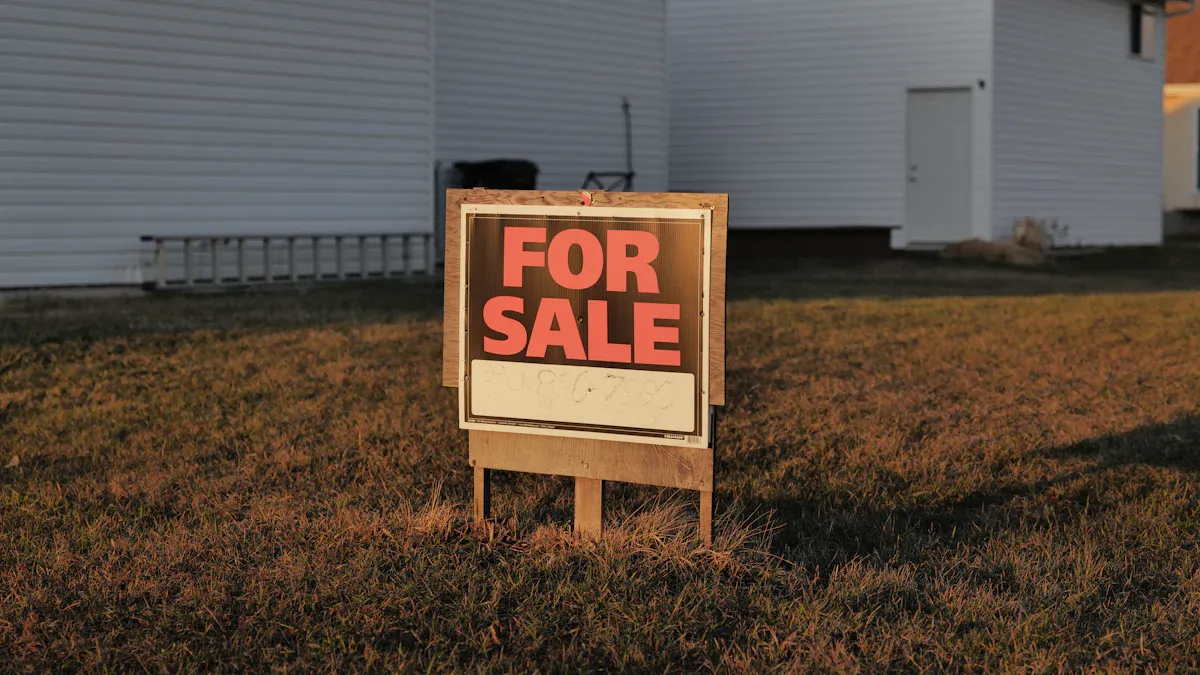- EasyCard
- Trade
- Help
- Announcement
- Academy
- SWIFT Code
- Iban Number
- Referral
- Customer Service
- Blog
- Creator
Will Rate Cuts Drive a Property Market Recovery or Fuel Bubble Risks? Expert Insights Dissected

Image Source: unsplash
The Bank of China’s rate cuts have a dual impact on the Hong Kong property market, with ongoing discussions about “recovery” versus “bubble” risks. Some experts point out that the low-interest environment created by the Bank of China’s rate cuts encourages funds to flow into the property market, boosting transaction volumes. Historical data shows that after the 1997 Asian Financial Crisis, property prices fell for six consecutive years, with interest rate changes closely tied to property price fluctuations.
Recent developments include:
- The chairman of Sun Hung Kai Properties stated that the Bank of China’s rate cuts may sustain a low-interest environment for two to three years, and property prices are unlikely to see significant fluctuations.
- Some developers, to boost sales, have reduced prices for certain new projects by up to 40%.
- Chinese property developers are using discounts to promote sales, reflecting adjustments in the property market under the Bank of China’s rate cuts.
Experts have differing views on whether the Bank of China’s rate cuts will inevitably lead to a property market rebound, making it worth exploring in depth.
Key Points
- Rate cuts effectively lower mortgage costs, easing monthly payment pressures for property owners, enhancing purchasing power, and boosting property market demand and transaction volumes.
- A low-interest environment attracts more funds into the property market, increasing investment appeal, but it also heightens risks of price overheating and bubbles, requiring cautious market assessment.
- Experts are divided on whether rate cuts will drive property market recovery or bubble risks, and investors should make rational judgments and decisions based on their financial situation and market changes.
- Choosing suitable mortgage products and conducting thorough financial assessments can help manage risks, avoid excessive leverage, and ensure long-term safety in property purchases and investments.
- Continuously monitoring policy developments and market data, and flexibly adjusting investment strategies, can effectively navigate property market fluctuations and seize recovery opportunities.
Rate Cuts and Property Market Recovery

Image Source: unsplash
Lower Mortgage Costs
Rate cuts directly reduce mortgage costs for homebuyers. According to China’s latest policy, the reverse repo rate was cut by 10 basis points from 2% to 1.9%, with the standing lending facility rate also adjusted downward accordingly. The market expects the five-year or longer Loan Prime Rate (LPR) to follow suit, potentially lowering the minimum first-home mortgage rate to 4%. These measures reduce residents’ interest expenses, and for every 10-basis-point cut, homebuyers’ monthly payment pressures are further alleviated.
In Hong Kong, for example, banks have cumulatively cut rates by 0.625 percentage points this year, lowering mortgage rates, reducing monthly payments, and significantly easing the burden on property owners.
Additionally, falling property prices and rising household incomes have further improved the mortgage affordability ratio. The table below shows relevant statistical data:
| Indicator | Change | Impact Description |
|---|---|---|
| Average Loan Rate of Top Five Banks | Rose from 1.721% to 1.847% | Theoretically increases affordability burden by 0.48% |
| Median Residential Property Price | Fell from USD 8.6 million to USD 8.5 million | Reduces affordability burden by 0.48% |
| Median Household Disposable Income | Rose from USD 878,000 to USD 884,500 | Reduces affordability burden by 0.30% |
| National Mortgage Affordability Ratio | Eased by 0.3% | Overall improvement in homebuying affordability |
| Mortgage Affordability Ratio in Six Major Cities | Eased in all but Kaohsiung, with Taipei easing by 1.01% | Mainly due to a USD 400,000 drop in residential prices |
These data reflect that rate cuts, combined with property price adjustments, effectively enhance homebuying affordability, laying the foundation for a property market recovery.
Increased Demand and Transactions
After rate cuts, lower funding costs boost buyer confidence, significantly increasing property market demand and transaction volumes. Experts note that rate cuts, combined with government relaxation of mortgage measures, are conducive to property market recovery.
In 2024, Hong Kong banks cut rates multiple times, lowering mortgage rates and monthly payments, attracting more buyers to the market. According to the latest statistics, Q4 2024 overall property registration volumes rose by about 32% compared to Q3, with first-hand private flats and second-hand residential registrations increasing by about 35.7%. Annual first-hand transactions reached about 16,000, up over 50% year-on-year, while second-hand residential transactions hit 40,000, up over 10% year-on-year, both marking three-year highs.
These data show that rate cuts effectively stimulate property market demand and transaction volumes, significantly improving market sentiment.
Enhanced Investment Appeal
In a rate-cut cycle, lower funding costs make real estate investment more attractive. The U.S. is expected to implement 2–3 rate cuts in 2024, each by about 25 basis points. Due to Hong Kong’s linked exchange rate system, the Hong Kong Monetary Authority follows the U.S. Federal Reserve in adjusting base rates, and the Hong Kong Interbank Offered Rate (HIBOR) experiences short-term fluctuations before trending downward overall, further reducing mortgage rates.
- Lower mortgage rates make new mortgages and floating-rate mortgages more attractive.
- U.S. rate cuts reduce global funding costs, making real estate investment more appealing compared to low-interest deposits.
- S&P 500 companies’ earnings forecasts are rebounding, with an optimistic economic outlook driving funds toward tangible assets.
Experts believe that with the Bank of China’s rate cuts and U.S. rate-cut expectations, the investment appeal of Hong Kong’s property market will continue to rise, with funds likely to flow further into the market, stabilizing transactions and prices.
Bank of China Rate Cuts and Mortgage Rates
Impact of Rate Changes
The Bank of China’s rate cuts directly affect Hong Kong’s mortgage rates. When the Bank of China cuts rates, Hong Kong banks adjust their prime rates, leading to lower mortgage rates. Past experience shows that for every 0.25 percentage point cut in mortgage rates, monthly payments for property owners can decrease by about 3%. This change significantly eases the financial burden on those with mortgages. For example, if a property owner originally paid USD 2,000 monthly, a rate cut could save about USD 60 per month. Such reductions are attractive to first-time buyers and those upgrading properties.
Bank stress tests are also adjusted in response to the Bank of China’s rate cuts. As rates fall, banks’ requirements for borrowers’ repayment capacity are relatively relaxed, increasing the likelihood of mortgage approval.
Improved Homebuying Capacity
The Bank of China’s rate cuts, by lowering mortgage rates, directly enhance citizens’ homebuying capacity. Reduced mortgage burdens allow more families to enter the market. According to market statistics, relaxed bank stress tests and related policies support banks’ lending capacity in the short term.
- Indonesia’s banking sector has sufficient capital to withstand higher non-performing loan pressures, indicating a robust financial system.
- Malaysia and Thailand’s banking sectors also maintain stable lending capacity due to policy adjustments.
- China’s banking sector has ample liquidity, with a financial system equipped with buffer capital to support economic recovery.
Hong Kong banks, in the Bank of China’s rate-cut environment, can increase lending ratios, benefiting more citizens. While uncertainties about economic recovery persist, the Bank of China’s rate cuts, combined with banking policies, create more favorable conditions for homebuyers.
Bubble Risk Analysis

Image Source: pexels
Fund Inflows into the Property Market
After rate cuts, lower funding costs make it easier for funds to flow into the property market. Hong Kong banks lower their prime rates, encouraging both investors and end-users to enter the market. In early 2024, fund inflows into Hong Kong’s property market increased significantly. According to Land Registry data, residential property registration amounts in Q1 2024 reached USD 18 billion, up about 25% year-on-year.
Experts note that after the Bank of China’s rate cuts, funds seek higher-return assets, with the property market becoming a popular choice. This can easily boost transaction volumes and prices, heating up market sentiment.
Concerns Over Price Overheating
Large fund inflows into the property market can lead to price overheating. When property prices surge rapidly in the short term, some buyers may chase prices out of “fear of missing out,” further driving prices upward. In 2021, Hong Kong’s residential property price index rose by over 12% in six months due to a low-interest environment and abundant funds.
Some experts warn that if property price increases far outpace residents’ income growth, the property market faces bubble risks.
The table below compares property price and income growth:
| Year | Property Price Increase | Resident Income Growth |
|---|---|---|
| 2021 | 12% | 2.5% |
| 2022 | -5% | 3% |
| 2023 | 3% | 2.8% |
When property price increases significantly outpace income growth, market adjustment pressures rise. Some experts suggest that investors should cautiously assess market entry timing to avoid buying at peak prices.
Risks of a Low-Interest Environment
A prolonged low-interest environment can cause asset prices to deviate from fundamentals. After the Bank of China’s rate cuts, lower mortgage rates in Hong Kong enable more people to borrow and enter the market. In such conditions, some buyers may overlook their financial risks and engage in excessive leverage.
Historical cases show that before the 1997 Asian Financial Crisis, Hong Kong’s property market saw rapid price surges due to prolonged low rates and abundant funds, leading to a bubble burst, with prices falling over 60% in six years.
Experts remind that in a low-interest environment, if the economy or interest rates reverse, property market adjustment pressures can escalate quickly. Investors and end-users should remain vigilant and avoid excessive borrowing.
Expert Views Comparison
Recovery Advocates’ Arguments
Recovery advocates believe that the Bank of China’s rate cuts will positively drive the property market. They emphasize improving economic fundamentals and sustained innovation momentum, citing multiple statistics and success cases:
- Patent applications for satellite sensing technology have grown 1,800% since 2001, far exceeding the global average.
- China leads in patent application volume, demonstrating the effectiveness of innovation and policy support.
- South Korea, France, and China have significantly improved their rankings in the global innovation index, reflecting effective government policies and innovation incentives.
- Even during the pandemic, innovation activities and investments remained active, driving economic recovery.
- Africa, Latin America, and the Caribbean have seen sustained innovation momentum, with clear global economic recovery trends.
Recovery advocates primarily rely on GDP growth rates, corporate investment, and private consumption data, believing that a comprehensive economic recovery will boost property market demand and capital market valuations.
Bubble Advocates’ Arguments
Bubble advocates focus on the short-term fund flows and asset price overheating driven by the Bank of China’s rate cuts. They argue that a low-interest environment easily attracts large fund inflows into the property market, inflating prices and increasing bubble risks. Bubble advocates emphasize:
- If property price increases far outpace resident income growth, market adjustment pressures will intensify.
- Exchange rate fluctuations and short-term fund movements significantly impact the property market, easily causing prices to deviate from fundamentals.
- Taiwan’s economic leading indicators and growth rates are influenced by short-term events like earthquakes, wars, and exchange rate fluctuations, requiring cautious data interpretation.
- Historical experience shows that prolonged low-interest environments increase the risk of property market bubble bursts.
Bubble advocates argue that investors should cautiously assess market risks and avoid excessive leverage.
Key Comparison
| Perspective | Recovery Advocates | Bubble Advocates |
|---|---|---|
| Data Indicators | GDP growth rate, corporate investment, private consumption | Exchange rate fluctuations, short-term fund movements, property price-to-income ratio |
| Main Arguments | Innovation momentum, policy support, comprehensive economic recovery | Fund inflows, price overheating, historical bubble experiences |
| Cases/Data | Patent application growth, innovation index improvements, global recovery trends | Rapid short-term property price surges, external event impacts, bubble burst cases |
| Risk Focus | Improving economic fundamentals | Asset price deviations, excessive leverage, adjustment pressures |
Expert views are supported by academic research, official statistics, and authoritative industry data, with sources clearly cited. Authors often have professional backgrounds and extensive experience, enhancing content credibility. The two sides differ in data selection and interpretation, and readers should make cautious judgments based on their own circumstances.
Homebuying and Investment Advice
Risk Management
When considering property purchases, investors should prioritize assessing risks from market policy changes. After Shanghai implemented the New Ten Measures for regulation, the proportion of speculative investors significantly declined, property prices stabilized, and market bubble components weakened. In August 2024, housing sales prices in 70 major Chinese cities rose 9.3% year-on-year, but the growth rate had noticeably narrowed. Experts note that while regulatory policies effectively curb bubbles, market views on policy directions remain divided, with some regions seeing rebounds.
Investors should closely monitor policy developments and regulatory enforcement, adjusting investment strategies based on their risk tolerance.
Additionally, local government debt and risks in small and medium-sized financial institutions can affect market confidence. By the end of 2023, China’s local government statutory debt balance reached RMB 40.74 trillion, with short-term improvements unlikely, requiring ongoing observation of market responses.
Mortgage Selection
Choosing the right mortgage product is critical for risk control. In the Bank of China’s rate-cut environment, Hong Kong banks have lowered mortgage rates, making floating-rate mortgages more attractive. Investors can choose fixed or floating-rate mortgages based on their cash flow and repayment capacity.
- Fixed-rate mortgages: Suitable for those with lower risk tolerance, locking in payment amounts to avoid rate fluctuation impacts.
- Floating-rate mortgages: Suitable for investors willing to bear rate fluctuation risks, benefiting from lower payment pressures during Bank of China rate cuts.
Bank stress tests should also be considered to ensure sufficient repayment capacity and avoid financial strain from rising rates.
Financial Assessment
Experts recommend using multiple performance and risk indicators for financial assessments. Common indicators include Sharpe Ratio, Sortino Ratio, and Maximum Drawdown (MDD).
- Sharpe Ratio measures the return-to-risk ratio, with higher values indicating better strategy performance.
- Sortino Ratio focuses on downside risk, suitable for evaluating conservative strategies.
- Maximum Drawdown (MDD) reflects the largest decline in portfolio value, and investors should assess their tolerance for drawdowns.
Backtesting data should cover bull, bear, and consolidation periods, excluding extreme outliers, to ensure strategy robustness. Investors should also compare performance against Buy & Hold strategies to evaluate operational value.
Financial assessments should focus not only on potential returns but also on risk tolerance and cash flow conditions, with careful fund allocation planning.
Rate cuts bring momentum for Hong Kong’s property market recovery but also harbor bubble risks.
- Hong Kong’s interbank offered rate fell from about 4% to 3.1%, lowering borrowing costs and increasing developers’ profits by an average of 5%.
- Lower mortgage rates reduce interest expenses for property owners, stimulating demand and stabilizing prices.
- Investor confidence rises, increasing transaction volumes, but the risk of price overheating cannot be ignored.
| Analysis Method | Indicator Description | Data Source |
|---|---|---|
| DuPont Analysis | Comprehensively reflects return on equity | Corporate financial data |
| Structural Analysis | Analyzes market share | Market sales data |
Experts recommend that investors cautiously assess their financial situation and market changes, avoid blindly following trends, and continuously monitor policies and expert views to make rational decisions.
FAQ
Will rate cuts inevitably lead to rising property prices?
Rate cuts can lower mortgage costs and stimulate demand, but property price trends are also influenced by economic and policy factors. Experts believe rate cuts do not guarantee rising prices.
What advantages do first-time buyers gain after mortgage rate cuts?
First-time buyers enjoy lower payment pressures and increased chances of passing bank stress tests. After Hong Kong banks cut rates, homebuying barriers are relatively lowered.
Does a prolonged low-interest environment increase property market bubble risks?
Prolonged low rates easily attract fund inflows, inflating prices. If the economy or rates reverse, adjustment pressures rise, increasing bubble risks.
How should investors manage property market risks?
Investors should closely monitor policy changes, cautiously assess their financial situation, choose suitable mortgage products, and avoid excessive leverage.
How do rate cuts affect the rental market?
Rate cuts lower mortgage costs, encouraging some owners to rent out units, increasing market supply. Rental yields may adjust due to property price fluctuations.
In 2025, Hong Kong’s property market teeters between recovery and bubble risks, with high fund management costs and cross-market trading complexities often hindering investors’ agility. BiyaPay offers a streamlined solution to seize investment opportunities. No need for additional overseas accounts—BiyaPay enables trading in both U.S. and Hong Kong stocks with a single account. Start now at BiyaPay!
BiyaPay supports real-time conversions across multiple fiat and digital currencies with transparent rate queries, ensuring cost clarity. With remittance fees as low as 0.5%, it minimizes financial barriers. Regulated by international financial authorities, BiyaPay guarantees secure transactions, empowering you to optimize property and investment strategies. Visit BiyaPay today to capitalize on market recovery!
*This article is provided for general information purposes and does not constitute legal, tax or other professional advice from BiyaPay or its subsidiaries and its affiliates, and it is not intended as a substitute for obtaining advice from a financial advisor or any other professional.
We make no representations, warranties or warranties, express or implied, as to the accuracy, completeness or timeliness of the contents of this publication.




Contact Us
Company and Team
BiyaPay Products
Customer Services
is a broker-dealer registered with the U.S. Securities and Exchange Commission (SEC) (No.: 802-127417), member of the Financial Industry Regulatory Authority (FINRA) (CRD: 325027), member of the Securities Investor Protection Corporation (SIPC), and regulated by FINRA and SEC.
registered with the US Financial Crimes Enforcement Network (FinCEN), as a Money Services Business (MSB), registration number: 31000218637349, and regulated by FinCEN.
registered as Financial Service Provider (FSP number: FSP1007221) in New Zealand, and is a member of the Financial Dispute Resolution Scheme, a New Zealand independent dispute resolution service provider.



















